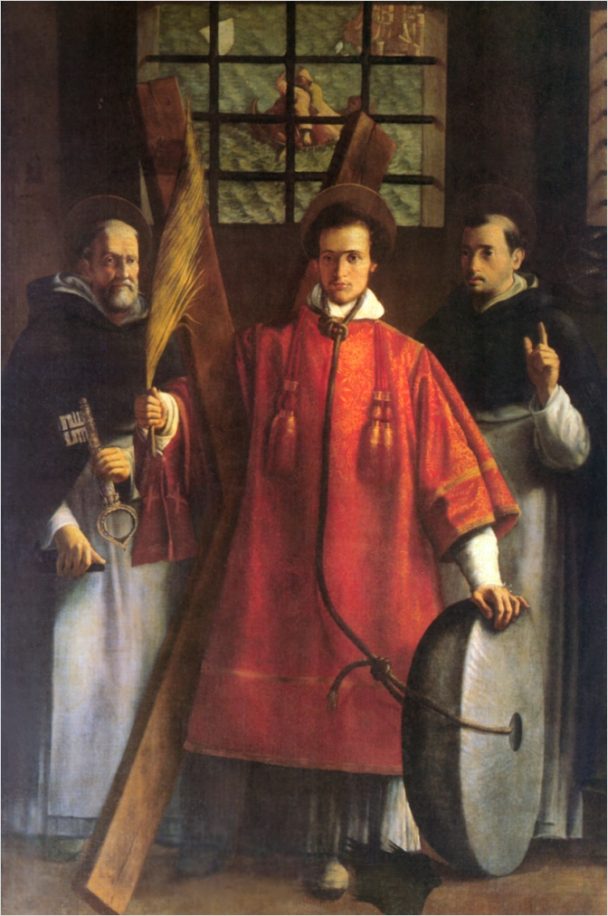Sts Vincent and Anastasius
St. Vincent
Deacon of Saragossa, and martyr under Diocletian, 304; mentioned in the Roman Martyrology, 22 Jan., with St. Anastasius the Persian, honoured by the Greeks, 11 Nov. This most renowned martyr of Spain is represented in the dalmatic of a deacon, and has as emblems a cross, a raven, a grate, or a fire-pile. He is honoured as patron in Valencia, Saragossa, Portugal etc., is invoked by vintners, brickmakers, and sailors, and is in the Litany of the Saints. His Acts were read in the churches of Africa at the end of the fourth century, as St. Augustine testifies in Sermon 275. The present Acts (Acta SS., III Jan., 6) date from the eighth or ninth century, and were compiled from tradition. Anal. Boll., I, 259, gives another life. All agree in substance with the metric life by Prudentius (P.L., LX, 378). He was born at Saragossa; his father was Eutricius (Euthicius), and his mother, Enola, a native of Osca. Under the direction of Valerius, Bishop of Sargossa, Vincent made great progress in his studies. He was ordained deacon and commissioned to do the preaching in the diocese, the bishop having an impediment of speech. By order of the Governor Dacian he and his bishop were dragged in chains to Valencia and kept in prison for a long time. Then Valerius was banished, but Vincent was subjected to many cruel torments, the rack, the gridiron, and scourgings. He was again imprisoned, in a cell strewn with potsherds. He was next placed in a soft and luxurious bed, to shake his constancy, but here he expired.
His body was thrown to be devoured by vultures, but it was defended by a raven. Dacian had the body cast into the sea, but it came to shore and was buried by a pious widow. After peace was restored to the Church, a chapel was built over the remains outside the walls of Valencia. In 1175 the relics were brought to Lisbon; others claim that they came to Castres in 864. Cremona, Bari, and other cities claim to have relics. Childeric I brought the stole and dalmatic to Paris in 542, and built a church in honour of St. Vincent, later called St-Germain-des-Prés. Regimont, near Bezières, had a church of the saint as early as 455. Rome had three churches dedicated to St. Vincent; one near St. Peter’s, another in Trastevere, and the one built by Honorius I (625-38) and renewed by Leo III in 796. A pilaster found in the basilica of Salona in Dalmatia shows an inscription of the fifth or sixth century in honour of the saint (Rom. Quartalschrift, 1907, Arch. 135).
St. Anastasius
St. Anastasius, once a magician, became a convert of the Holy Cross and was martyred in 628. He was a soldier in the army of Chosroes when that monarch carried the Cross from Jerusalem to Persia. The occasion prompted him to ask for information; then he left the army, became a Christian, and afterwards a monk in Jerusalem. His Persian name, Magundat, he changed to Anastasius. After seven years of the most exact monastic observance, he was moved, as he thought, by the Holy Ghost to go in quest of martyrdom and went to Cæsarea, then subject to the Persians. Reproaching his countrymen for their magic and fireworship, both of which he had once practised, he was taken prisoner, cruelly tortured to make him abjure, amid finally carried down near the Euphrates, to a place called Barsaloe, or Bethsaloe, according to the Bollandists, where his sufferings were renewed while at the same time the highest honours in the service of King Chosroes were promised him if he would renounce Christianity. Finally, with seventy others, he was strangled to death and decapitated, 22 January, 628. His body, which was thrown to the dogs, but was left untouched by them, was carried thence to Palestine, afterwards to Constantinople, and finally to Rome.
Sources
BUTLER, Lives of the Saints; STADLER, Heiligenlexicon; ALLARD, Hist. des persecut., IV, 237; LECLERCQ, Les Martyrs, II (Paris, 1903), 437.
Acta SS., 3 Jan.; BUTLER, Lives of the Saints, 22 Jan.
APA citation. Mershman, F. (1912). St. Vincent. In The Catholic Encyclopedia. New York: Robert Appleton Company. Retrieved January 23, 2022 from New Advent: http://www.newadvent.org/cathen/15434b.htm
APA citation. Campbell, T. (1907). St. Anastasius. In The Catholic Encyclopedia. New York: Robert Appleton Company. Retrieved January 23, 2022 from New Advent: http://www.newadvent.org/cathen/01455c.htm


DIVINE INTIMACY PAGE GUIDE
The Power of the Divine Teacher
Meditation No. 55, Page 154
Buy the book here
View the full Divine Intimacy Calendar
Mass readings
